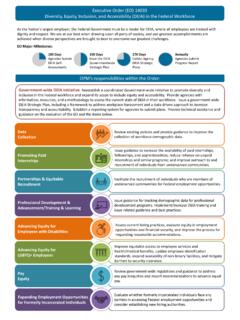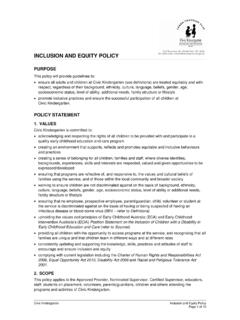Transcription of Equity, Diversity, and Inclusion
1 equity , diversity , and Inclusion INCLUSIVE LANGUAGE GUIDELINES. Suggested citation American Psychological Association. (2021). Inclusive language guidelines. diversity - This material may be produced and distributed for noncommercial purposes only, provided that acknowledgment is given to the American Psychological Association and/or the material is reproduced in its entirety (including cover and title pages). This material may not be translated without prior permission in writing from the American Psychological Association. FOREWORD. For the first time, APA is systematically and institutionally examining, acknowledging, and charting a path forward to address its role in racism and other forms of destructive social hierarchies including, but not limited to, sexism, ableism, ageism, heterosexism, classism, and religious bigotry.
2 The organization is assessing the harms and is committing to true change. This requires avoiding language that perpetuates harm or offense toward members of marginalized communities through our communications. As we strive to further infuse principles of equity , diversity , and Inclusion (EDI) into the fabric of society, those committed to effecting change must acknowledge language as a powerful tool that can draw us closer together or drive us further apart. Simply put, words matter. The words we use are key to creating psychologically safe, inclusive, respectful, and welcoming environments. These guidelines aim to raise awareness, guide learning, and support the use of culturally sensitive terms and phrases that center the voices and perspectives of those who are often marginalized or stereotyped.
3 They also explain the origins for problematic terms and phrases and offer suitable alternatives or more contemporary replacements. This document will be flexible and iterative in nature, continuing to evolve as new terminology emerges or current language becomes obsolete. By embracing inclusive language and encouraging others to do the same, we firmly believe that we will not only communicate effectively with more people, but also better adapt to a diversifying society and globe. Maysa Akbar, PhD, ABPP. Chief diversity Officer ABOUT THIS RESOURCE. These inclusive language guidelines are written for those working to champion equity , diversity , and Inclusion in the spaces that they learn, teach, work, or conduct research.
4 This includes, but is not limited to, APA staff, volunteer leaders, members, students, affiliated organizations, and EDI professionals working across various industries. The document draws directly from the bias-free language guidelines of the Publication Manual of the American Psychological Association, Seventh Edition (APA, 2020b). The guidance offered is intended to be used in conjunction with, not in place of, those guidelines. Various APA publications also influenced the information presented within, namely the equity , diversity and Inclusion Framework (APA, 2021b); numerous policy resolutions and practice guidelines; and the APA Dictionary of Psychology (APA, ). We also relied on articles published in peer-reviewed psychology journals and the collective expertise of subject matter experts among our staff and APA committees.
5 Finally, we consulted inclusive language guidelines from the Brandeis University Prevention, Advocacy and Resource Center and the Native American Journalists Association. Please note that the explanations in this document are distinct and separate from how these words are defined and interpreted under law. ACKNOWLEDGMENTS. We would like to thank specific APA staff who directed this resource with passion and resolve: equity , diversity , and Inclusion Executive Office Public Interest Maysa Akbar, PhD, ABPP, Chief diversity Officer Clinton Anderson, PhD, Acting Chief of Psychology in the Public Interest Nadia Dawood, MS, equity , diversity , and Inclusion Manager Tanya Dozier, Assistant Director, Women's Programs Portfolio Triven Parker, MPH, Sr.
6 Director EDI Planning & Integration Kelley Haynes-Mendez, PsyD, Director, Ethnic, Racial, Mia Smith-Bynum, PhD, Sr. Director for Science equity and Cultural Affairs Portfolio Keyona King-Tsikata, MPH, Sr. Director, Health equity and Communications Access Team, and Sr. Director, Socioeconomic Status Portfolio Alicia Aebersold, Chief Communications Officer Ron Schlittler, MIPP, Assistant Director, Sexual Orientation Efua Andoh, Public Engagement Manager and Gender diversity Portfolio Dani Poole, Senior Marketing Manager Meggin Van der Hilst, AuD, Director, Disability Issues Trent Spiner, Editor-in-Chief in Psychology Portfolio Susan Straight, Managing Editor Latrice Vinson, PhD, Director, Aging Portfolio Callie Strobel, Graphic Designer Publishing Ayanna Adams, MA, Editor, APA Style Executive Office Arthur C.
7 Evans Jr., PhD, Chief Executive Officer Emily Ayubi, Director, APA Style and Executive Vice President Chelsea Lee, MA, Content Development Manager, APA Style Ellen Garrison, PhD, Senior policy Advisor Rose Sokol-Chang, PhD, Publisher, APA Journals and Books Human Resources Office of General Counsel Ismael Rivera, Director Donna Euben, JD, Deputy General Counsel We would like to thank the following APA governance groups for their review: Committee on Aging Committee on Sexual Orientation and Gender diversity Committee on Disability Issues in Psychology Committee on Socioeconomic Status Committee on Ethnic Minority Affairs Committee on Women in Psychology TABLE OF CONTENTS. Inclusive Language in Writing 2.
8 General Terms Related to equity and Power 2. Person-First and Identity-First Language 6. Identity-Related Terms 7. Age 7. Disability Status 8. Race, Ethnicity, and Culture 10. Sexual Orientation and Gender diversity 15. Socioeconomic Status 17. Avoiding Microaggressions in Language 18. Culturally Appropriative and Pejorative Language 18. Violent Language 19. Language That Doesn't Say What We Mean 19. References 20. Inclusive Language in Writing GENERAL TERMS RELATED TO equity AND POWER. access The elimination of discrimination and other barriers that contribute to inequitable opportunities to join and be a part of a work group, organization, or community (APA, 2021b). ally/allies People who recognize the unearned privilege they receive from society's patterns of injustice and take responsibility for changing these patterns.
9 Being an ally is more than being sympathetic and feeling bad for those who experience discrimination. An ally is willing to act with, and for, others in pursuit of ending oppression and creating equality. Real allies are willing to step out of their comfort zones. Those who decide to undertake the ally role must recognize and understand the power and privileges that one receives, accepts, and experiences and they use that position to act for justice (Akbar, 2020). bias APA defines bias as partiality: an inclination or predisposition for or against something. Motivational and cognitive biases are two main categories studied in decision-making analysis. Motivational biases are conclusions drawn due to self- interest, social pressures, or organization-based needs, whereas cognitive biases are judgments that go against what is considered rational, and some of these are attributed to implicit reasoning (APA, 2021b).
10 Climate The degree to which community members feel included or excluded in the work group, organization, or community (APA, 2021b). cultural competence Ability to collaborate effectively with individuals from different cultures; such competence improves health care experiences and outcomes (Nair & Adetayo, 2019). AMERICAN PSYCHOLOGICAL ASSOCIATION INCLUSIVE LANGUAGE GUIDELINES 2. discrimination The unjust and differential treatment of the members of different age, gender, racial, ethnic, religious, national, ability identity, sexual orientation, socioeconomic, and other groups at the individual level ( , behavioral manifestation of prejudice involving negative, hostile, and injurious treatment of the members of targeted groups; APA, 2021b) and the institutional/structural level ( , operating procedures, laws, and policies) that favor certain groups over others and has the effect of restricting opportunities for other groups.

















